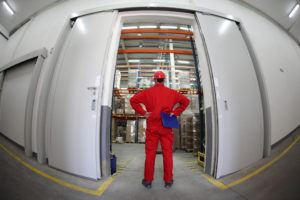By Becky Ferrell
My 2-way radio clicked. “Ferrell, come to A7 immediately!” I knew that voice. It was my plant manager, John. And he didn’t sound happy, never a good thing. Grabbing my safety glasses, I shut down my computer and headed to the floor and column A7. There stood John, scowling.
“Ferrell, been watching the production monitoring system. The station over there is repeatedly starved for parts and it’s impacting line throughput. I’m hearing your drivers aren’t delivering timely. Frankly, I don’t know if that’s the problem or not. That’s your job to figure out; I just want it fixed. So, you STAND HERE until you do. Understand?” And with that he walked off.
Here. Here? I looked around. I was nowhere near the station in question. I mean, I was within eyesight, but definitely down the line from the station. It took me a few minutes of thought, and suddenly, I understood why John had selected this spot. From this vantage point, I could watch several stations without being obvious, so none of the operators knew specifically who or what I was watching. The longer I stood here, the more I simply receded into the background.

WATCH AND LEARN
Sigh…. Ok. Now I understood the location. Let’s get at figuring out exactly what’s going on with product delivery / throughput.
The station was set up with three pallets in station, two full (one from which the operator was able to access parts) and one station for empty dunnage. Standard operator instructions were as soon as the first pallet was emptied, the empty dunnage was indexed to the pick-up station and the “call” button was pushed. The call signal went to our “taxi station” board, and the next available driver would pick up the call. That driver would retrieve and bring a full pallet to the station, removing the empty. If the process was followed, the operator should always have parts. So where was the process failing?
As I watched the job, I noticed the operator did not always hit the call button as soon as the empty pallet was indexed, sometimes waiting until he was part way into the next pallet before calling. Material replenishment was totally subject to his timing of the call. Wait too long, and the cycle time for replenishment would ensure he would get some “rest” while waiting for parts….. starved.
DEVELOPING A HYPOTHESIS
OK. I had a hypothesis on what was happening, but now how to lay this out, using data, so it didn’t look like Materials was simply blaming Manufacturing. John didn’t like problems that didn’t come with solutions based on data. (Hey, most managers don’t!)
Luckily, the relatively new plant had installed both production and materials systems that tracked and maintained data. Using the data from the materials system, I was able to document all the relevant data regarding the call and delivery of material: the time the call went out, time the driver picked up the call, time the material was delivered to the line. From the production monitoring system, the same system that told John the station was being starved, I was able to retrieve the time the line shut down due to lack of parts and the time it restarted.
Correlating the information from these systems and putting it in an easily readable format, the data clearly told the story of calls for material being made later than standard work dictated. The solution? Automate the call so as soon as the empty pallet shuttled to the side, a call to Materials automatically called for replenishment.
This probably should be the end to this story, but truly it isn’t. The “Stand Here” lesson proved to be applicable time and again. During my tenure as a Lean Calibrator, we focused on “continuous improvement.” I found my lesson from John invaluable.
FINDING A SOLUTION
Need to improve a workstation? Don’t stand IN or BY the workstation, for several reasons. First, you may be in the way. Second, you may never see how the operator(s) truly function in the station since your presence may ensure they perform as they SHOULD and not as they actually do.
At one calibration in China, I stopped and viewed a workstation. Using the “Stand Here” lesson, I moved across the aisle and several yards away. The workers, assuming I’d moved on with the tour group of calibrators, resumed their “normal” methods of doing things. In the space of less than one-half hour I was able to document over a dozen potential improvements in that work station.
A simple process, non-threatening to the operators, but yielding multiple opportunities for continuous improvement in a very short period of time. You can learn a lot using “Stand Here” – are operators following standard work or do they have a better method but perhaps don’t feel free to suggest it, are there ergonomic issues, walk distances, material delivery or method issues, tool and equipment placement issues? Just to name a few.
Lesson learned, John – and, though I never told you before, thanks.
It doesn’t have to be a fresh set of eyes to create value by identifying opportunities for improvement. However, there are times when managers are so focused on ensuring operators are following standardized work they miss the subtle messages from operators demonstrating a better way to do things. With time constraints placed on managers today, let HVM resources help identify continuous improvement opportunities in your manufacturing organization!
Did you enjoy this blog? Search our blog library for other topics of interest: https://highvaluemanufacturingconsulting.com/blog/
